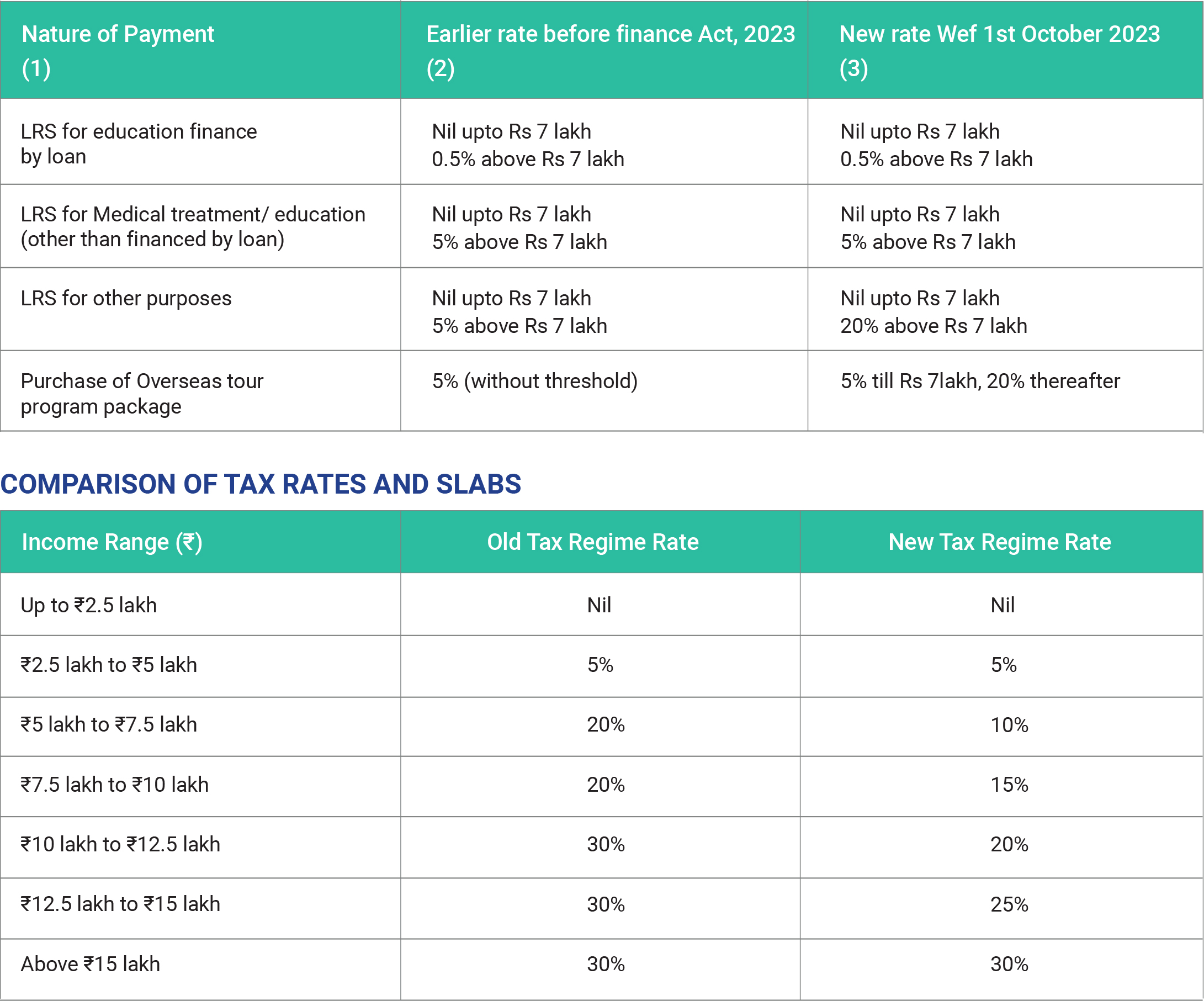The Union Budget 2023 unveiled a comprehensive
package of reforms, social programs, and regulatory
changes aimed at propelling India's development. This
Budget introduced significant changes to India’s tax
landscape, with a particular focus on international
financial transactions. While the revised income tax slabs
garnered much attention, modifications to the Tax
Collected at Source (TCS) under the Liberalised
Remittance Scheme (LRS) also had a substantial impact
on individuals sending money abroad. Let's explore into
the world of foreign remittances and the recent changes
brought about by the Indian government.
WHAT IS LRS?
The Liberalised Remittance Scheme (LRS) is a framework
established by the Reserve Bank of India (RBI) that allows
Indian residents to remit a certain amount of money
abroad for various permissible transactions. The
Liberalised Remittance Scheme (LRS) is a great help to
the one who does international transactions.
KEY FEATURES OF LRS
• Remittance Limit: Under LRS, Indian residents
can remit up to $250,000 per financial year for various
purposes, including education, travel, medical treatment,
and investments abroad.
• Permissible Transactions: The remittances can
be used for various purposes such as: Education
expenses, Medical treatment, Travel, Investments in
foreign assets and, Gifts and donations
• No Restrictions on Frequency: There are no
restrictions on the number of transactions, but the total
amount remitted must not exceed the annual limit.
• Documentation: Individuals must provide
necessary documentation, including a Permanent
Account Number (PAN), to facilitate remittances.
WHAT IS TCS IN FOREIGN REMITTANCE TRANSACTIONS?
TCS, short for, Tax Collected at Source, is the type of
income tax collected by the seller of selected goods and
services from the buyer. In the context of Foreign
Remittance Transactions, this kind of tax can be collected
from sender when he sends money abroad. Here, it is
crucial to note that sending money doesn’t only mean
sending it to someone. It could even imply touring abroad,
shopping, investing abroad, purchasing assets, etc.
CHANGES PROPOSED IN BUDGET 2024
• For remittances under LRS, other than for
education and medical treatment, the TCS rate has been
reduced from 20% to nil for amounts up to ₹7 lakh per
financial year, effective retrospectively from July 1, 2023.
• For payments for overseas tour program
packages, the TCS rate has been reduced from 20% to 5%
for amounts up to ₹7 lakh per financial year, effective
retrospectively from July 1, 2023.
• A 20% TCS rate is applicable from October 1,
2023, for remittances under LRS (other than for education
and medical treatment) and payments for overseas tour
program packages exceeding ₹7 lakh in a financial year.
• International payments via debit card or Forex
card exceeding ₹7 lakh in a financial year are now subject
to LRS and a 20% TCS rate.
• International credit card payments have been
excluded from the ambit of LRS, effectively exempting
these transactions from TCS regulations.
• For educational expenses, there is no TCS on
foreign remittances below ₹7 lakh. For amounts above ₹7
lakh, TCS is 0.5% if the remittance is through a loan from
an approved financial institution, and 5% if not funded by
a loan.
• Any remittance for medical treatment above ₹7
lakh is subject to TCS at 5%.
• These changes aim to rationalise the TCS regime
for remittances under LRS, providing relief for lower-value
transactions while maintaining oversight for higher-value
remittances. The exclusion of international credit card
payments from LRS was a notable change in response to
practical challenges taxpayers face. LRS provides Indian
resident individuals with the flexibility to remit funds
abroad for various purposes, while adhering to the limits,
documentation requirements and tax implications set by
the regulations. Investors should be cautious to ensure
compliance with RBI guidelines.

KEY DIFFERENCES
• Tax Structure: The new regime has introduced
more tax brackets and lower rates for incomes up to ₹15
lakh, making it attractive for individuals who do not claim
many deductions.
• Deductions and Exemptions: Old Regime: Allows
numerous deductions, including those under Section 80C
(up to ₹1.5 lakh), HRA, LTA, and others, totalling around 70
deductions. New Regime: Offers limited deductions,
primarily the standard deduction of ₹50,000 and employer
contributions to NPS under Section 80CCD(2). The new
regime does not allow most exemptions and deductions
available in the old regime.
• Rebate Threshold: Under the new regime,
individuals earning up to ₹7 lakh can avail of a full tax
rebate, effectively making their income tax-free. In
contrast, the old regime provided a rebate only for
incomes up to ₹5 lakh.

